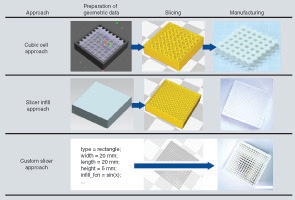Abstract
Aim: The aim of this study is the creation of microlattices with spatial distribution via additive extrusion for medical applications, and investigation of the related software tools. Materials & methods: Three approaches for lattice generation are compared and tested on a standard 3D printer. First, the geometry is filled with cubic cells. Second, infills of standard slicer software are used. Last, a custom solution for infill generation is presented. Results: Printability of the cubic cells is limited to three-times the nozzle orifice diameter. The other two approaches create lattices of high quality compromised of one strand at the size of the nozzle orifice diameter, while only the custom solution can create arbitrary spatial distributions. Conclusion: The involved software tools should have to be optimized for every application, but pave the way for customized and functional parts.
All 3D-printing methods share the workflow of cutting a virtual model into layers in a slicer software and using proprietary strategies for physical modeling. For medical applications, not only the outer appearance but also the inner microstructure is of major importance. Looking at an extrusion-based printing of porous microstructures, this software piece mainly limits achievable structure sizes and distribution, which is necessary, for example, for improving osseointegration. We compared different approaches for this task. First, the structures were created as geometry data, with limited performance. Next, different slicers were compared and evaluated. Smaller regular structures could be created. In the end, we present a custom slicer solution that is capable of printing microlattices of high quality with a complex spatial distribution.

Financial & competing interests disclosure
The authors have no relevant affiliations or financial involvement with any organization or entity with a financial interest in or financial conflict with the subject matter or materials discussed in the manuscript. This includes employment, consultancies, honoraria, stock ownership or options, expert testimony, grants or patents received or pending, or royalties.
No writing assistance was utilized in the production of this manuscript.
